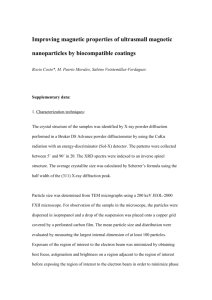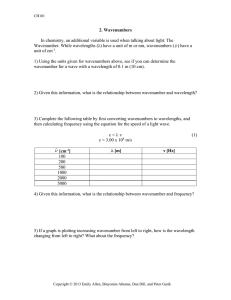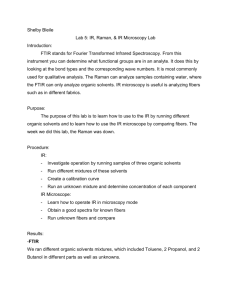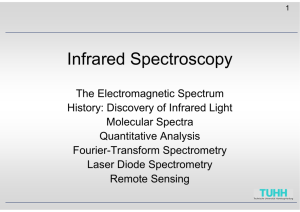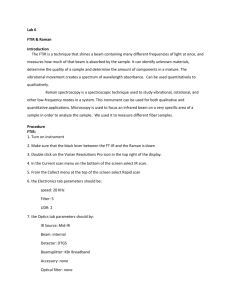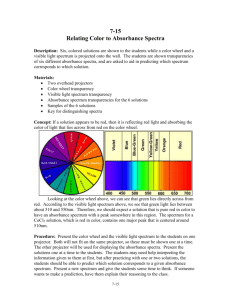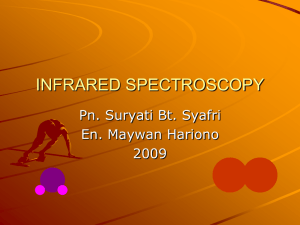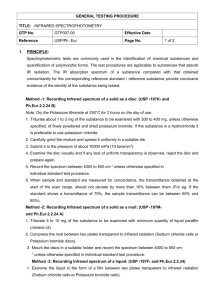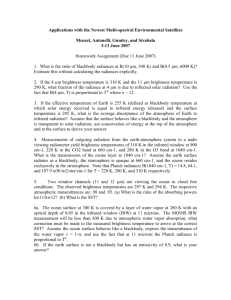Fund FTIR Intro Module with Sound for Online Course
advertisement
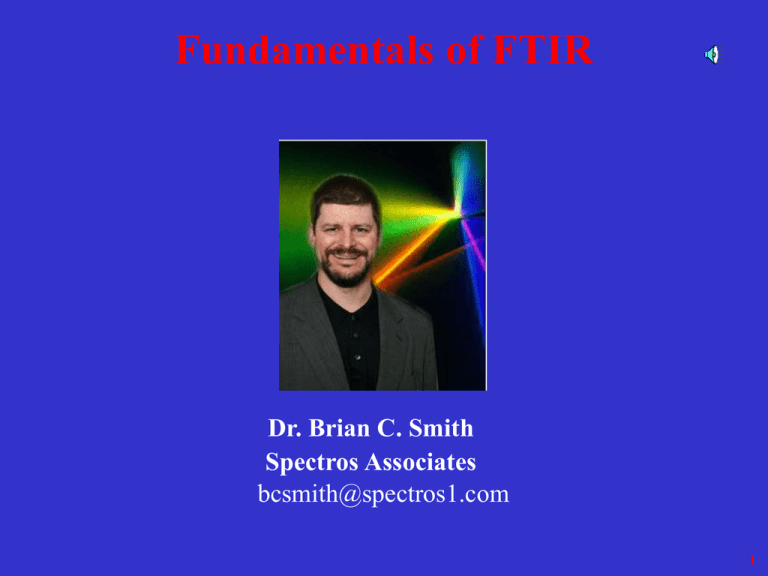
Fundamentals of FTIR Dr. Brian C. Smith Spectros Associates bcsmith@spectros1.com 1 Terms and Definitions Spectroscopy – The study of the interaction of light with matter Infrared Spectroscopy – The study of the interaction of infrared light with matter Electromagnetic Radiation – a wave that consists of an electric vector and magnetic vector undulating in perpendicular planes, propagating in a third plane. Translation – light, heat, radio waves, microwaves, X-rays, gamma rays etc. Cycle – When a wave traverses zero three times Wavelength (l) – length/cycle – in FTIR, typically use light of wavelengths of 2.5 to 25 microns Frequency (n) – cycles/second Wavenumber - cycles/cm Photon Energy = hcW – Where h = Planck’s constant, c = light speed, W = Wavenumber Mid-IR Radiation – 4000 to 400 cm-1. Same thing as heat. – Most molecules in the universe have strong absorbances in this wavenumber range 2 Wavelength and Cycles l 1 Cycle Figure 1.1. A plot of the amplitude of the electric vector part of a light wave versus time. The arrow denotes the distance between adjacent crests, and is called the wavelength, l. 3 Properties of Light: Wavenumbers Wavenumber (W) is 1/Wavelength or – W = 1/l – If l is in units of length, W is in units of (length)-1 – e.g. l is in cm, W is in cm-1 W Measures the # of Cycles per Unit Length – e.g. # of cycles/cm Light Energy Wavenumber In FTIR, Typically Use Mid-IR Light – 4000 to 400 cm-1 light If a peak is at 3000 wavenumbers, it is absorbing light of 3000 cycles/cm. 4 The Electromagnetic Spectrum > 14,000 cm-1 Visible UV & Xrays 14,000 to 4000 cm-1 Near Infrared 4000 to 400 cm-1 Mid Infrared Higher Wavenumber Higher Frequency Higher Energy Shorter Wavelength 400 to 4 cm-1 Far Infrared <4 cm-1 Microwaves Radio Waves Lower Wavenumber Lower Frequency Lower Energy Longer Wavelength Figure 1.2. The electromagnetic spectrum, showing the wavenumber ranges for different types of light. 5 An Infrared Spectrum A Plot of Light Intensity vs. Some Property of Light Typically Wavenumber on the X-Axis Normally high W is to the LEFT Figure 1.3. The infrared spectrum of polystyrene plotted in absorbance units on the Y-axis. 6 Transmittance Units Figure 1.4. The transmittance spectrum of polystyrene. 7 Y Axis Units Y-Axis May be in Absorbance or Transmittance Absorbance: A = log(I0/I) where I0 = Bkgd. Spectrum & I = Sample Spectrum – – – – Measures amount of light absorbed by sample Peaks Point UP. Peak intensity should be < 2 A (pathlength)(concentration) or A lc. Absorbance MUST be used for quantitative measurements Transmittance: T = (I/I0) the fraction of light transmitted Percent Transmittance: %T = 100x (I/I0) – The percentage of light transmitted – Peak point down, should be > 10% – Okay for qualitative analysis, but not for quant. since has a non-linear relationship with concentration 8 Which Y Axis Unit Should You Use? Which Unit Should You Use, Absorbance or Transmittance? Quantitative Analysis: MUST Use Absorbance – The relationship between absorbance and concentration is linear. The relationship between %T and concentration is NON-linear. Qualitative Analysis: Either unit, may be determined by boss, tradition or SOP – Qualitative analysis means trying to identify chemical structures from the spectrum Absorbance units are required for spectral subtraction, library searching and quantitation. – Rather than having to convert to perform these operations, may be simpler to always measure absorbance spectra. Get used to reading both – Spectra in the book are plotted both ways 9 Peak Size Limit Peaks Can Be “Too Big” – If Abs. > 2 or %T < 10, almost all light is absorbed. – Mineral Oil Peaks in Bottom Spectrum are Distorted – Change pathlength or concentration to get peaks the “right” size 10 What are Spectra Used For? Determine Unknowns – “What molecule(s) are in this sample? – Use peak positions of known functional groups Identities (Spectral Comparisons) – “Are these two samples the same?” – Must have a reference spectrum for comparison – Easier than unknowns, but still must be done properly Quantitation – What is(are) the concentration(s) of molecule(s) in this sample – Must first obtain a calibration, lots of experimental work involved 11
